I’ll never forget the first time I served this banana cream cheesecake at a family gathering. My uncle who’d always claimed to dislike “fancy desserts” went back for seconds, then thirds, before finally asking for the recipe. That’s the magic of this particular creation. It transforms simple, familiar ingredients into something that feels both comforting and sophisticated.
What makes this banana cream cheesecake special is the perfect balance between rich creaminess and fresh banana flavor. Unlike many recipes that rely on artificial extracts, we’ll be using real, ripe bananas to infuse authentic flavor throughout every layer. You’ll also appreciate how this recipe combines classic cheesecake techniques with some clever shortcuts that save time without sacrificing quality.
Ingredients & Substitutions
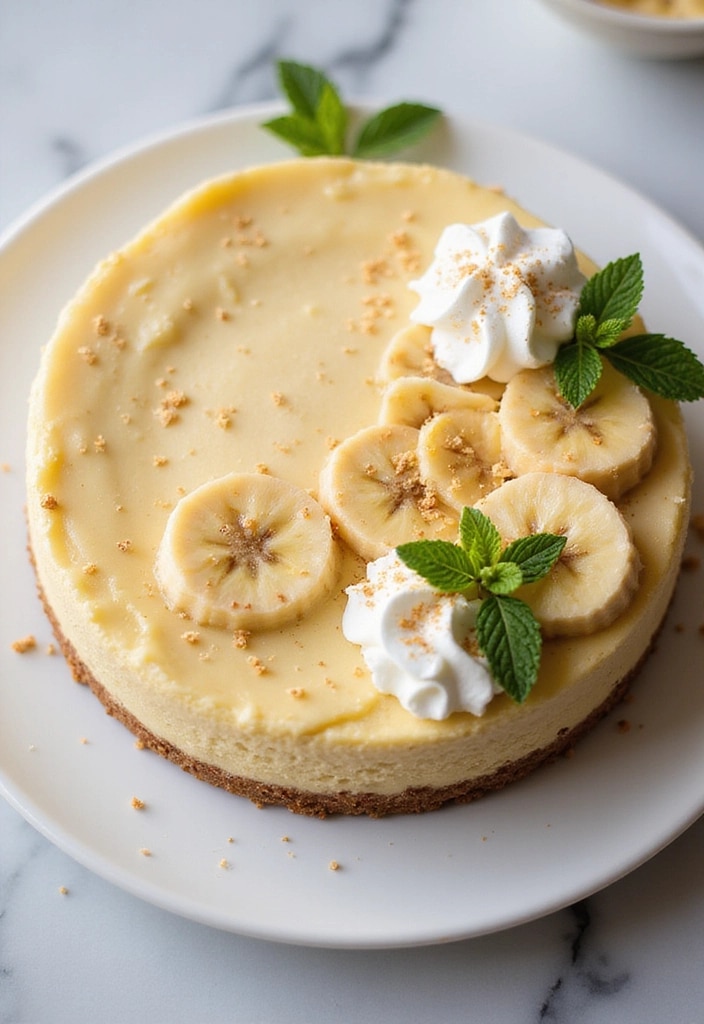
For the Crust:
- 2 cups graham cracker crumbs (about 15 full sheets)
- 1/3 cup granulated sugar
- 1/2 cup (1 stick) unsalted butter, melted
- 1 teaspoon cinnamon (optional)
If graham crackers aren’t available, digestive biscuits work beautifully as a substitute. For those avoiding gluten, gluten-free graham crackers or even crushed gluten-free vanilla cookies mixed with a tablespoon of almond flour will create a similar texture and flavor profile. The quality of your butter matters here European-style butter with higher fat content will yield a richer, more flavorful crust that holds together exceptionally well.
For the Cheesecake Filling:
- 4 packages (8 oz each) cream cheese, room temperature
- 1 cup granulated sugar
- 4 large eggs, room temperature
- 1 tablespoon vanilla extract
- 1/4 cup sour cream
- 1/4 cup heavy cream
- 3 medium ripe bananas, mashed (about 1 1/2 cups)
Using room temperature ingredients is absolutely crucial here cold cream cheese will lead to lumps that never fully incorporate. If you’re dairy-sensitive, lactose-free cream cheese works suprisingly well, though the texture will be slightly less dense. Neufchâtel cheese (⅓ less fat than cream cheese) can be substituted, but your cheesecake will have a softer set and slightly tangy flavor.
For the Banana Cream Layer:
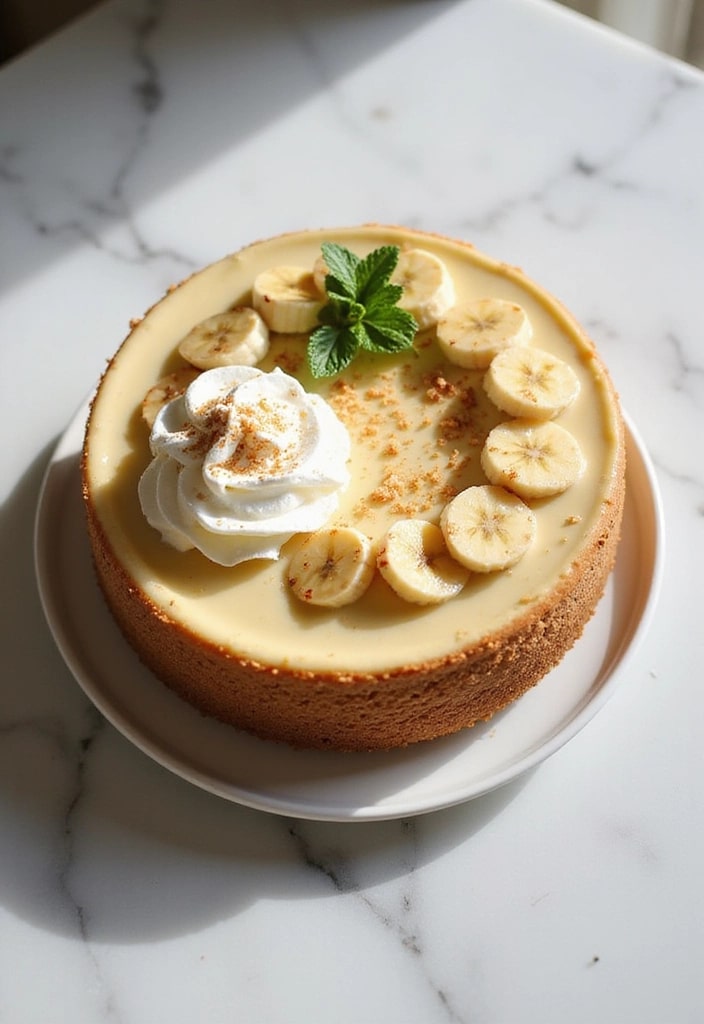
- 1 package (3.4 oz) instant banana pudding mix
- 1 1/2 cups cold milk
- 1 cup heavy whipping cream
- 3 tablespoons powdered sugar
- 1 teaspoon vanilla extract
- 2 ripe bananas, sliced
For a completely homemade approach, you can skip the pudding mix and make a traditional banana custard, but honestly, the convenience of instant pudding creates consistant results that’s hard to beat. Coconut milk (full-fat, not light) can replace regular milk for a tropical twist. Choose bananas with small brown spots for the perfect sweetness—they should be ripe but still firm enough to hold their shape when sliced.
For the Topping:
- 1 cup heavy whipping cream
- 3 tablespoons powdered sugar
- 1 teaspoon vanilla extract
- 1 banana, sliced
- 2 tablespoons caramel sauce
- Crushed vanilla wafers (optional)
Whipped coconut cream makes an excellent dairy-free alternative for the topping, tho you’ll need to refrigerate the can overnight first. When selecting bananas for garnish, pick ones that are just barely ripe to prevent browning. A quick dip in lemon water can also help preserve their color for presentation.
Step-by-Step Instructions
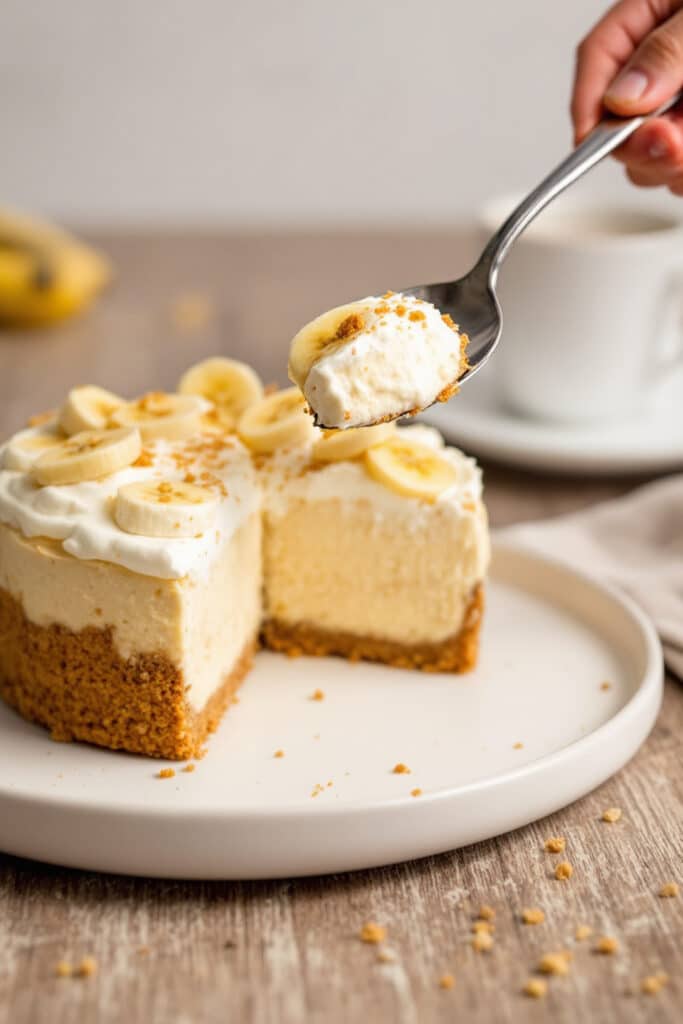
Preparing the Crust
- Preheat your oven to 325°F (165°C) and position the rack in the middle. Proper oven temperature is more important than you think many home ovens run hot or cold, so an oven thermometer is a worthwhile investment.
- In a medium bowl, combine graham cracker crumbs, sugar, and cinnamon (if using). Pour in the melted butter and mix until the mixture resembles wet sand. A common mistake is not mixing thoroughly enough—every crumb should be coated with butter for the crust to hold together properly.
- Press the mixture firmly into the bottom and about 1 inch up the sides of a 9-inch springform pan. Use the bottom of a measuring cup to compress the crust—this creates a more even surface than using your fingers alone. Bake for 10 minutes, then remove and cool completely on a wire rack.
Making the Cheesecake Filling
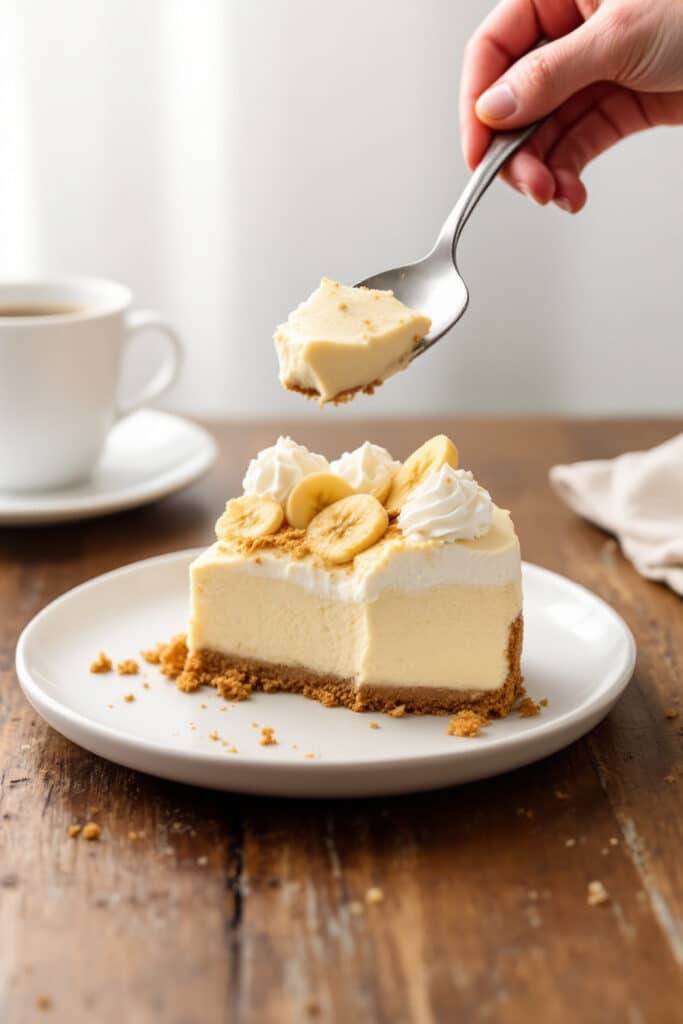
- Reduce your oven temperature to 300°F (150°C). Lower, slower baking prevents cracks and ensures a creamier texture. Meanwhile, wrap the outside of your springform pan with aluminum foil, ensuring it comes at least halfway up the sides to prevent water from seeping in during the water bath.
- In a large mixing bowl, beat the cream cheese on medium-low speed until completely smooth, about 4 minutes. Scrape down the sides and bottom of the bowl several times during this process—unmixed lumps hidin near the bottom are the most common reason for a lumpy cheesecake.
- Gradually add sugar and continue beating until smooth and creamy. Add eggs one at a time, mixing on low speed just until each is incorporated. Overbeaten eggs incorporate too much air, which can cause the cheesecake to puff up and then crack as it cools.
- Mix in vanilla extract, sour cream, and heavy cream until just combined. Gently fold in the mashed bananas. The key word here is “fold” aggressive mixing will deflate the air you’ve carefully incorporated, resulting in a dense rather than creamy texture.
- Pour the filling into the cooled crust and smooth the top with an offset spatula. Place the foil-wrapped springform pan in a larger roasting pan, then add hot water to the roasting pan until it reaches about halfway up the sides of the springform.
- Bake for 1 hour and 15 minutes, or until the edges are set but the center still has a slight jiggle—think of the consistency of set Jell-O. Turn off the oven, crack the door open about an inch, and let the cheesecake cool in the oven for 1 hour. This gradual cooling prevents the dramatic temperature change that often leads to cracking.
- Remove from the oven, run a thin knife around the edge to loosen the cake from the sides of the pan, then cool completely at room temperature. Refrigerate for at least 6 hours, preferably overnight. Patience really pays off here—a properly chilled cheesecake is easier to slice and has a more developed flavor profile.
Creating the Banana Cream Layer
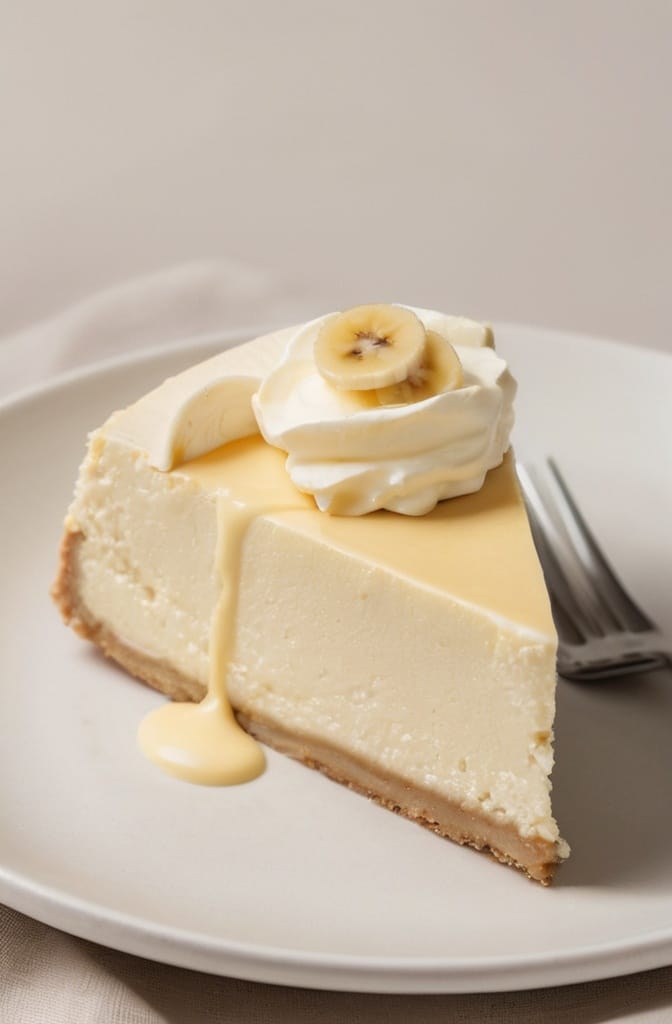
- In a medium bowl, whisk together the instant banana pudding mix and cold milk for 2 minutes, until it begins to thicken. Refrigerate for about 5 minutes to set slightly while you prepare the whipped cream component.
- In a separate bowl, beat the heavy cream with powdered sugar and vanilla until stiff peaks form. Be careful not to overbeat—cream can quickly go from perfectly whipped to grainy and butter-like in seconds.
- Gently fold the whipped cream into the pudding mixture until fully incorporated. This lightens the pudding and creates that irresistable mousse-like texture that elevates this cheesecake beyond the ordinary.
- Arrange a layer of sliced bananas on top of the chilled cheesecake, then carefully spread the banana cream mixture over the top. Return to the refrigerator for at least 2 hours to set. This layer needs adequate chilling time to achieve the right consistency—rushing will result in a filling that’s too soft to slice cleanly.
Finishing Touches
- Just before serving, whip the remaining cup of heavy cream with powdered sugar and vanilla until soft peaks form. Pipe or spread the whipped cream on top of the banana cream layer, creating decorative patterns if desired.
- Arrange the remaining banana slices on top, then drizzle with caramel sauce. If using, sprinkle crushed vanilla wafers around the edge for a contrasting texture. A professional trick is to freeze banana slices for 10 minutes before arranging them—they’re easier to place precisely and won’t sink into the whipped cream.
- Remove the sides of the springform pan and transfer the cheesecake to a serving plate. For the cleanest slices, dip your knife in hot water and wipe it dry between cuts—this technique creates those picture-perfect restaurant-style slices.
Cooking Techniques & Science
The water bath (bain-marie) used in this recipe isn’t just cheffy showing-off—it serves a crucial purpose. Cheesecake is essentially a custard, and custards benefit from gentle, even heat. The water acts as an insulator, preventing the edges from cooking too quickly and helping maintain a consistent temperature throughout the baking process. This is why your cheesecake will have that perfectly smooth, crack-free surface.
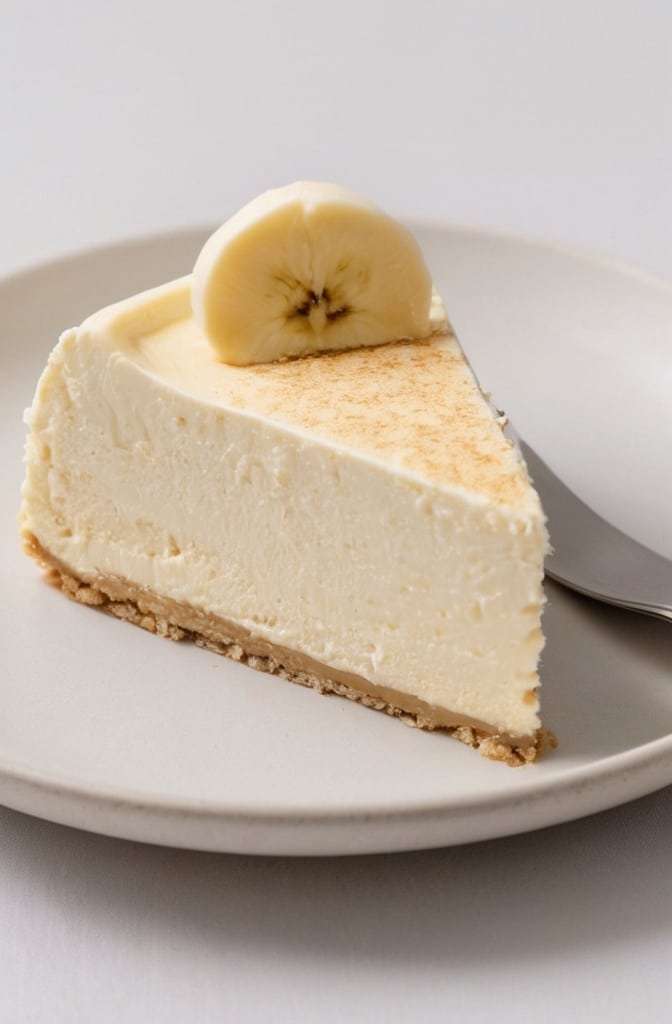
Another interesting aspect is the role of acid in cheeescake. The slight tanginess of cream cheese and sour cream isn’t just for flavor—the acidity helps denature the proteins in the eggs, creating that signature silky texture. Without this acidity, the proteins would bind too tightly, resulting in a rubbery rather than creamy consistency.
Bananas bring their own challenges to baking. They contain enzymes that can break down proteins and starches, which is why they’re incorporated after the eggs rather than earlier in the process. Additionally, their high moisture content and sugars mean they caramelize beautifully when baked, adding depth of flavor to the cheesecake layer.
For equipment, a stand mixer with a paddle attachment is ideal for cheesecake because it incorporates ingredients without adding excessive air. If using a hand mixer, use a lower speed setting than you might think necessary. A springform pan is non-negotiable here the removable sides are essential for unmolding the cheesecake without damage.
Serving & Pairing Suggestions
This banana cream cheesecake shines as a centerpiece dessert, especially when presented on a pedestal cake stand. For individual servings, consider using a hot knife to cut clean slices, then place each on a small pool of caramel sauce with a mint leaf for color contrast.
For a more dramatic presentation, try flambeéing thin banana slices in rum and brown sugar just before serving, then arranging them while still warm atop each slice. The temperature contrast between warm bananas and cold cheesecake creates a sensory experience your guests won’t forget.
Coffee pairings elevate this dessert to sublime heights. A rich espresso or cold brew coffee balances the sweetness perfectly. For alcoholic pairings, banana liqueurs like Banane du Brésil or even a good aged rum complement the tropical notes in the cheesecake.
As for complementary dishes, this cheesecake works beautifully as the sweet finale following spicy Caribbean cuisines or hearty Southern comfort food. The cooling creaminess provides a perfect counterpoint to heat and richness in the preceding courses.
Conclusion
Creating this banana cream cheesecake is more than following instructions—it’s about understanding the delicate balance between textures and flavors. The crisp graham crust, velvety cheesecake, cloud-like banana cream, and fresh banana garnish each contribute their own character to the whole experience.
Don’t be intimidated by the multiple steps. Each component builds on the last, creating layers of flavor that simply can’t be achieved in simpler recipes. The techniques you’ll master here—creating the perfect water bath, achieving that ideal creamy texture, and building complementary layers—will serve you well in countless other desserts.
Remember that the best cheesecakes improve with time. While it’s tempting to serve this beauty as soon as possible, allowing it to chill overnight develops a depth of flavor that’s well worth the wait. Trust me on this—I’ve learned the hard way after rushing more than one cheesecake to the table.
Frequently Asked Questions?
Can I make this cheesecake without a springform pan?
You can use a deep dish pie plate in a pinch, but you’ll lose the dramatic presentation of the tall sides and may have difficulty removing clean slices. If using a regular pan, consider lining it with parchment paper with overhanging edges to help lift out the cheesecake after chilling.
How do I prevent my bananas from turning brown on top of the cheesecake?
Brush your decorative banana slices with a mixture of 1 tablespoon lemon juice and 1 tablespoon honey. This not only prevents oxidation but also adds a subtle shine. Alternatively, add the banana garnish just before serving rather than in advance.
My cheesecake cracked! Can I fix it?
Absolutely! The banana cream layer will cover any cracks perfectly. For future reference, cracks typically result from overmixing (incorporating too much air), sudden temperature changes, or overbaking. The water bath and slow cooling methods in this recipe should help prevent most cracking issues.
Can I freeze this cheesecake?
The cheesecake base freezes beautifully for up to 2 months if well-wrapped. However, I recommend adding the banana cream layer and toppings fresh after thawing. The texture of the banana cream layer can become watery when frozen and thawed.
How ripe should my bananas be for this recipe?
For the mashed bananas in the filling, choose very ripe bananas with significant brown spotting for maximum sweetness and flavor. For the sliced bananas in the cream layer and garnish, use just-ripe bananas (yellow with slight green at the stems) for better structural integrity and less browning.
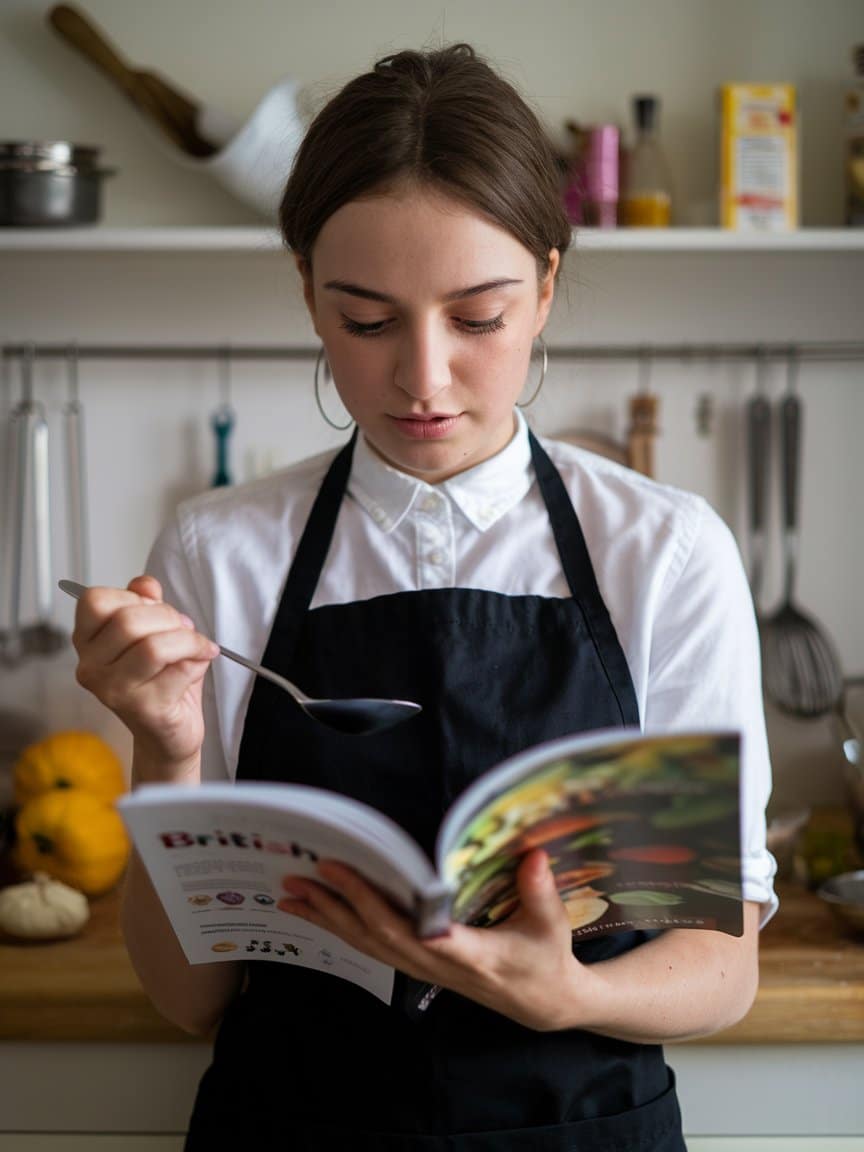
Veronica is a passionate food enthusiast with over three years of experience in exploring and writing about diverse cuisines. Her expertise lies in reviewing restaurants, sharing creative recipes, and discovering the latest food trends. As the voice behind FoodieRecap.com, Anju brings fresh perspectives and culinary insights to her audience.
